reMIND
Introduction One
Religion in literature is hard to do well. One of the greatest struggles for a literary work concerned with faith in the unseen is negotiating that breach between Why Should I Care and Hey You're Preaching At Me. The borderlands that lie between the two are filled with deep and often satisfying conversations—or at least ones that help readers to recognize the breadth of perspectives that naturally hover across the human landscape. And then consider even those works that don't press us to think seriously about what it means to be human in the face of all else that exists—if they resonate with us without dogmatizing, we tend to appreciate them a bit more. And this is a phenomenon unique to the realm of fiction.
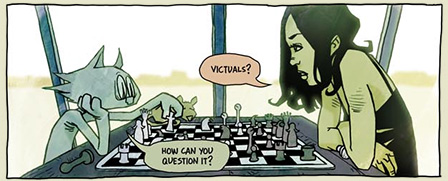
When picking up a brick of text called Beliefs of the Coptic Church, one would likely be disappointed if the book hemmed and hawed and only vaguely laid out what the Coptic Church might believe. We not only excuse blatant and direct reference to a particular theological dogma when reading a reference work discussing that dogma's merits—we expect it. Fiction, on the other hand, long ago ceased its comfortable position as a vessel to convey a distinct and particular moral. Such overtly displayed lessons as found in "The Fox and the Grapes" are largely seen as reliquary, a nod to a long-passed and primitive kind of reader. Nowadays we, for good or for ill, are embarrassed by fictions that wear their heart too immodestly exposed.
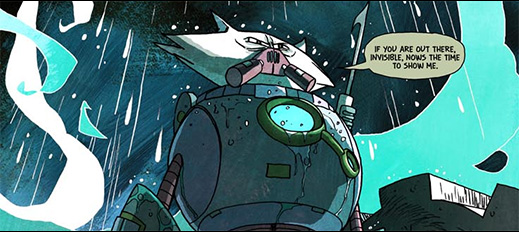 p.s. I am Iron Cat
p.s. I am Iron Cat
At least we are when we're not members in good standing of the particular choir that is being preached to in a work. Christians who read Doug TenNapel's CreatureTech seem a lot less fidgety around the book's very very Christian climax. Atheists and those who've fled fundamentalist Christianity seem much more willing to overlook Craig Thompson's rather weighted evaluation of churchgoers in Blankets. The problem with each of these works is that we feel a little too handily that we are being preached at. It's an uncomfortable thing: first because whenever the author's agenda overwhelms the story, we lose sense of their world being a real kind of place; and second because fiction is so well suited to discussion that most contemporary readers will find its repurposing for monologue a bit jarring.11It's possible that Blankets almost sidesteps this by almost being non-fictional. The book is ostensibly a recapitulation of Thompson's childhood growing up in fundamentalist America but is in reality a fictionalization of that experience (at least more so a fictionalization than any straightforward memoir would be). Strangely enough, Tezuka's Buddha very neatly dodges the awkwardness of the dogma question despite similarly being a fictionalization of religious history and presenting its story as True Fact. The loophole might rest both in that Tezuka's life of the Buddha is filled with blatant fantasy elements and in that the book doesn't really ever take itself very much seriously at all—if a movie of the life of Christ received similar treatment, it would be picketed more than Scorsese's Last Temptation.
Happily Jason Brubaker's reMIND doesn't, I think, fall into this trap. It has things to say about belief, questions to ask, but it does so with enough humility that one can easily forget that it was even about a question of faith. And really, maybe it's not about that. Maybe religion is just part of the world he's unveiled for the space of this story and maybe the book is about living, and so naturally treats our beliefs in unseen possibilities.

In any case, while Brubaker employs direct reference to a divine entity (the Invisible) and even some less overt clues as to whom the Invisible might best represent, he keeps it oblique, allowing readers to make their own decisions about his characters' cosmogony. In CreatureTech, Doug TenNapel wallops readers over the head by having his non-believing protagonist actually flatout encounter the divine and witness crucifixion. It's a crude hammer the size of Mjolnir that TenNapel uses to pound penny nails into an Ikea version of faith and belief. (Fortunately, TenNapel almost redeems his book through sheer madcap humour—what he lacks in subtlety, he nearly makes up for in bravado.)
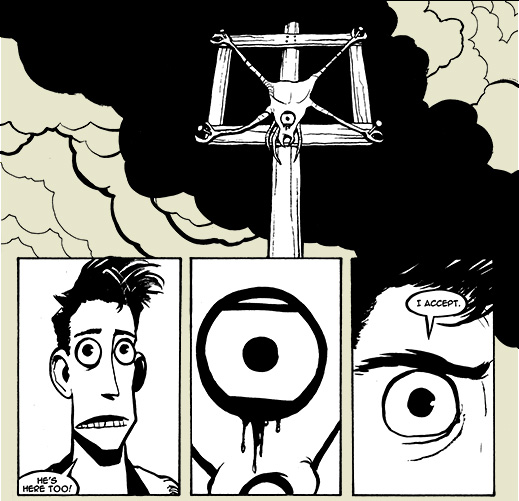 This is when TenNapel's hero in Creaturetech actually experiences Jesus the Christ on an alien world in alien guise.
This is when TenNapel's hero in Creaturetech actually experiences Jesus the Christ on an alien world in alien guise.
Brubaker's path is more thoughtful and more considerate and more enjoyable and hits less like the eighteen-wheeler of belligerent proselytizing than TenNapel's. reMIND's characters have no direct encounter with the divine. No vision. No dream. No voice in the midst of fire or storm. Their Invisible remains invisible and if they continue to believe, they do so out of faith, out of a hope in things not seen. And because of this, I found that I could enjoy Brubaker's story for what it was rather than have to stop and think about what I thought about how much I agreed or disagreed with his characters' personal ideologies.
Introduction Two
reMIND is one of those books that I thought was going to be one thing and was excited about the thing I thought it was going to be and then it turned out to be something else entirely and I was a little disappointed and then forty pages later I didn't care and was excited again. The book opens with gorgeous art depicting a mechanically inclined woman named Sonja climbing a tower to do some work on a propeller turbine.

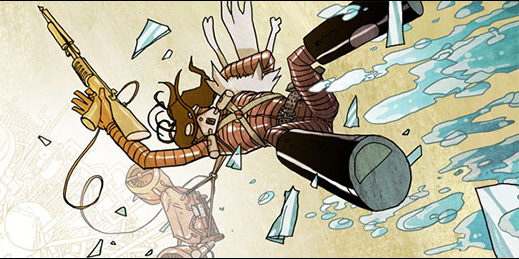
Pretty quickly, things take a turn for more wild and rambunctious paths. Talking animals, undersea civilizations, body-swapping, political coups. I blew through both (handsomely packaged!) volumes of reMIND rather quickly. Maybe over a couple hours? Maybe less? Even though his book is not the quiet character study I'd injudiciously hoped for, it's very good at being exactly what it is: a sometimes adventure, sometimes fantasy, sometimes theological rumination.
The Art
The first thing most readers will notice—before the talking cat, before the talking lizard, before the talking rat, before the talking sea anemone—is Brubaker's art. It's gorgeous, actually gorgeous. I read that he works (worked?) for Dreamworks animation. After reading reMIND, it's obviously to their credit that they thought to hire him. reMIND's visual troposphere is a beautiful mix of alien and familiar. Though deeply unlike, it reminds me of Moebius in that. His characters have the kind of fluidity that those with animation backgrounds tend to boast over their other comics-illustrating compatriots. As well, the book does a good job designwise, laying out some wonderful panels and scenes.

His character designs are usually pretty tight, even if often more cartoony than I generally prefer—the design for the lizard princess Cyrene is particularly good, being both grotesque and beautiful simultaneously.

I appreciated Brubaker's use of Photoshop (or some similar image-editing/creating software) for colouring. He uses, I believe, a number of watercolour washes (and oils) masked and recoloured to lend texture to his art.22I guess this to be the case because I use the same technique in my own illustration work and think it looks pretty nice. Colour me biased. His colour choices are vibrant and fit the proposed mood well.

Another technique he employed that I thought worked particularly well focused on the use of white, overlit backgrounds to silhouette his foreground action. The effect creates a kind of bloom around figures, increasing their dynamism and pushing the reader to sense action even in the static.
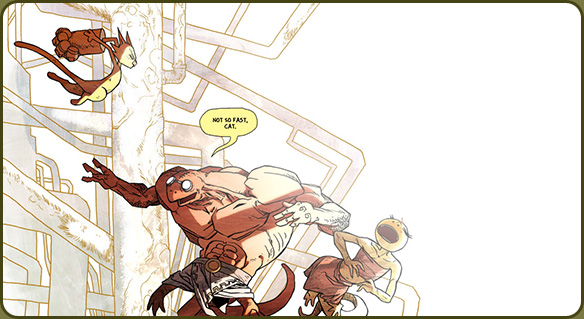
Brubaker uses digital blurs to create dimensionality rather than strictly relying on colour cues as most (colour) comics would.

Anything Else?
reMIND is above all else: fun. It's primarily an adventure story, the tale of righting a kingdom's wrongs. It has other stuff (like the religion aspect), but those things may seem more like local colour meant to add solidity to Brubaker's world rather than to stand as the book's purpose. reMIND is an enjoyable romp that may or may not prompt further reflection on its themes. If it does, fantastic. The self-examined life and all that. If it doesn't, it's still a pretty bitchen little story.
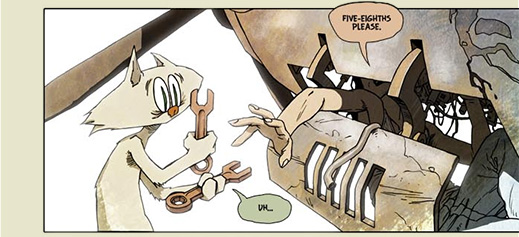
And maybe its sequel will be about Sonja's life on the outskirts of a society that can never truly understand or appreciate her. And how that affects her love life!33Maybe Jason Brubaker is better off not consulting me with what to do next.
Bonus
Because I'm completely awesome, Jason Brubaker drew a picture of Victuals the cat in my books.

Actually, I lied. It had nothing to do with how awesome I may or may not be. It's just 'cuz he's a nice guy.
Good Ok Bad features reviews of comics, graphic novels, manga, et cetera using a rare and auspicious three-star rating system. Point systems are notoriously fiddly, so here it's been pared down to three simple possibilities:
3 Stars = Good
2 Stars = Ok
1 Star = Bad
I am Seth T. Hahne and these are my reviews.
Browse Reviews By
Other Features
- Best Books of the Year:
- Top 50 of 2024
- Top 50 of 2023
- Top 100 of 2020-22
- Top 75 of 2019
- Top 50 of 2018
- Top 75 of 2017
- Top 75 of 2016
- Top 75 of 2015
- Top 75 of 2014
- Top 35 of 2013
- Top 25 of 2012
- Top 10 of 2011
- Popular Sections:
- All-Time Top 500
- All the Boardgames I've Played
- All the Anime Series I've Seen
- All the Animated Films I've Seen
- Top 75 by Female Creators
- Kids Recommendations
- What I Read: A Reading Log
- Other Features:
- Bookclub Study Guides










